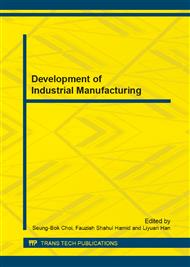[1]
LIN Zongjian, LI Deren, XU Yanying. General review on the new progress of earth observations[J]. Science of Surveying and Mapping, 2011, 36(4): 5-8. (In Chinese).
Google Scholar
[2]
Seitz S M, Curless B, Diebel J, Scharstein D, Szeliski R. A comparison and evaluation of multi-view stereo reconstruction algorithms[C]. /Computer Vision and Pattern Recognition, 2006 IEEE Computer Society Conference on. IEEE, 2006, 1: 519-528.
DOI: 10.1109/cvpr.2006.19
Google Scholar
[3]
Calakli F, Ulusoy A O, Restrepo M I, et al. High Resolution Surface Reconstruction from Multi-view Aerial Imagery[C]/3D Imaging, Modeling, Processing, Visualization and Transmission (3DIMPVT), 2012 Second International Conference on. IEEE, 2012: 25-32.
DOI: 10.1109/3dimpvt.2012.54
Google Scholar
[4]
Furukawa Y, Ponce J. Accurate, Dense, and Robust Multiview Stereopsis[J]. Pattern Analysis and Machine Intelligence, IEEE Transactions on, 2010, 32(8): 1362-1376.
DOI: 10.1109/tpami.2009.161
Google Scholar
[5]
Scharstein D, Szeliski R. A taxonomy and evaluation of dense two-frame stereo correspondence algorithms[J]. International journal of computer vision, 2002, 47(1-3): 7-42.
DOI: 10.1109/smbv.2001.988771
Google Scholar
[6]
Liang T, Heipke C. Automatic relative orientation of aerial images[J]. Photogrammetric engineering and remote sensing, 1996, 62(1): 47-55.
Google Scholar
[7]
Hirschmuller H. Stereo vision in structured environments by consistent semi-global matching[C]/Computer Vision and Pattern Recognition, 2006 IEEE Computer Society Conference on. IEEE, 2006, 2: 2386-2393.
DOI: 10.1109/cvpr.2006.294
Google Scholar
[8]
Hirschmuller H. Stereo processing by semiglobal matching and mutual information[J]. Pattern Analysis and Machine Intelligence, IEEE Transactions on, 2008, 30(2): 328-341.
DOI: 10.1109/tpami.2007.1166
Google Scholar
[9]
JIANG W S. Multiple Aerial Image Matching and Automatic Building Detection [D]. Wuhan: Wuhan University, 2004. (In Chinese ).
Google Scholar
[10]
ZHANG Guo, CHEN Tan, PAN Hongbo, JIANG Wanshou. Patch-based Least Squares Image Matching Based on Rational Polynomial Coefficients Model[J]. Acta Geodaetica et Cartographica Sinica, 2010, 39( 3): 264-270. (In Chinese).
Google Scholar
[11]
ACKERMANN F. High Precision Digital Image Correlation[C] / Proceeding of 39th Photogrammetry Week. Stuttgart: [s. n. ], 1983: 231-243.
Google Scholar
[12]
ROSENHOLM D. Multi-point Matching Using the Least Squares Technique for Evaluation of Three-dimensional Models[J]. Photogrammetric Engineering and Remote Sensing, 1987, 53(6): 621-626.
Google Scholar
[13]
BALTSAVIAS E P. Multiphoto Geometrically Constrained Matching[D]. Zurich: Institute of Geodesy and Photo-grammetry, ETH, 1991: 221-229.
Google Scholar


